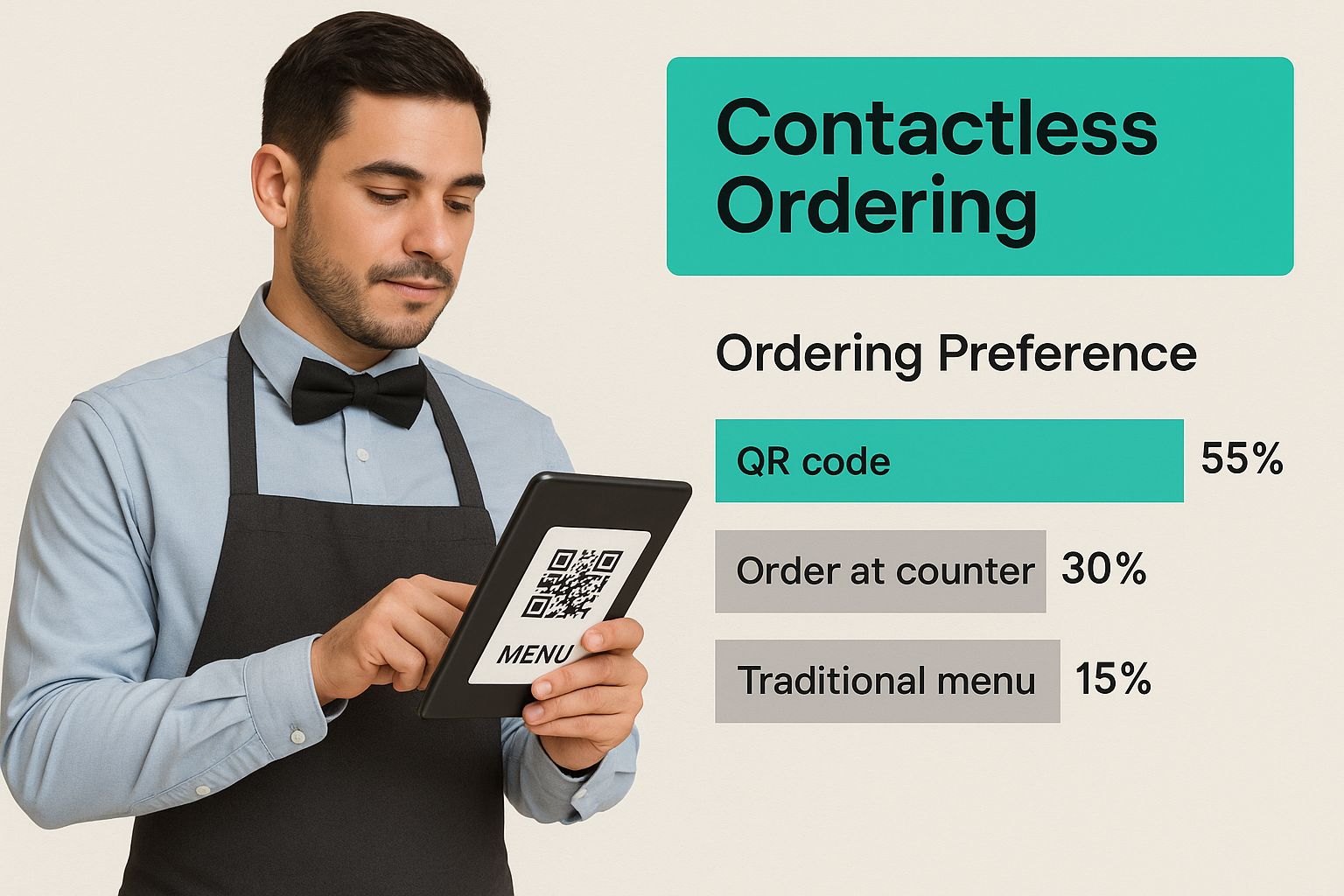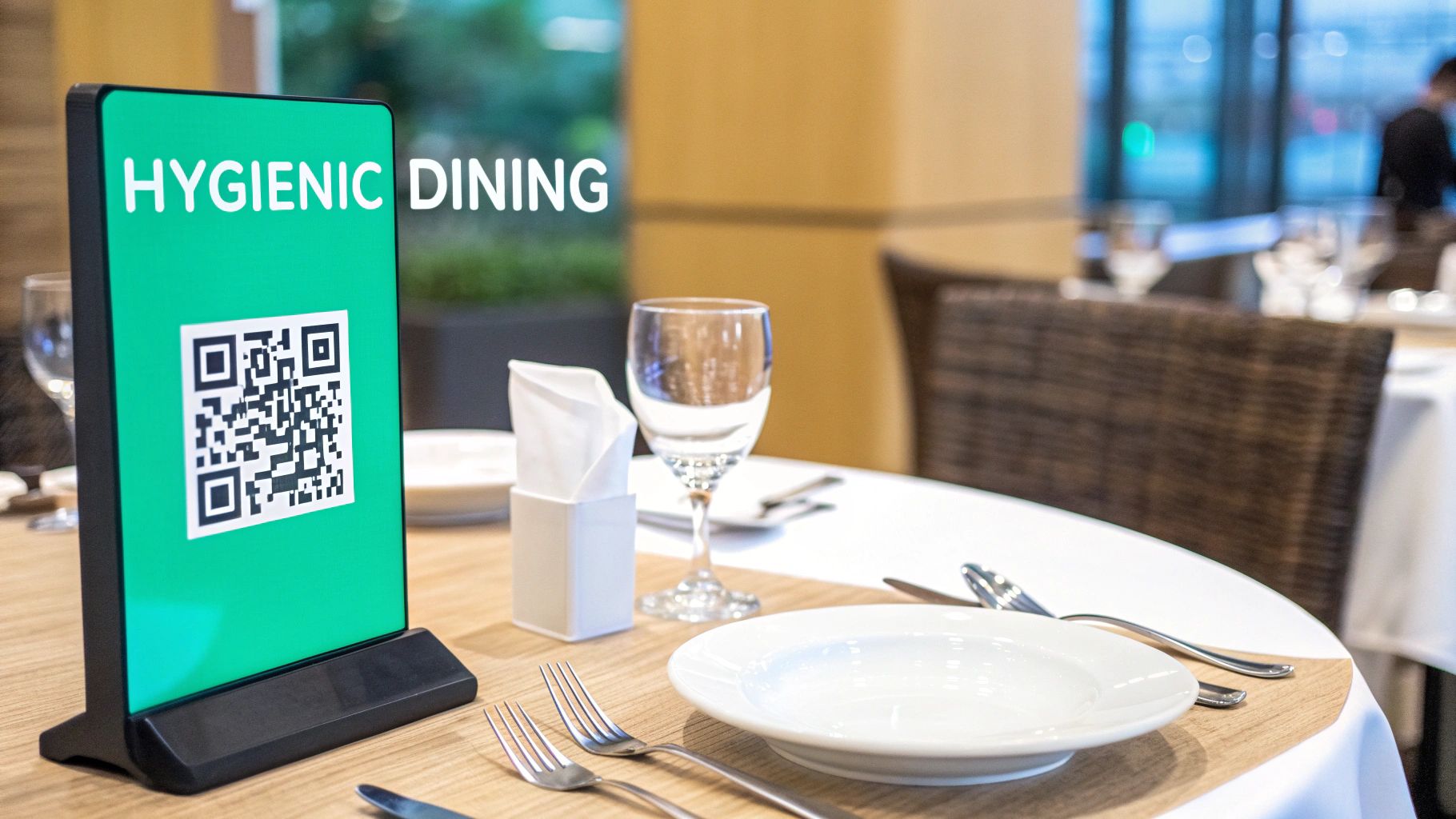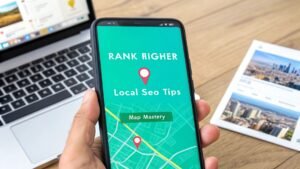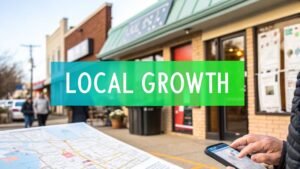Why Smart Restaurants Are Embracing QR Code Menus
QR code menus might have started as a pandemic workaround, but savvy restaurant owners quickly saw their true value. Chatting with owners, from casual eateries to upscale dining, it's clear how much these digital menus have changed things. Managers who were once skeptical now rave about them, especially seeing 15-20% boosts in table turnover and major savings on printing. This isn't just a trend; it's a fundamental shift in customer expectations. Younger diners especially often appreciate the quick, easy ordering experience QR codes provide. Early adopters have even found unexpected perks, like instantly adjusting menus for supply shortages and collecting useful data on customer preferences. Speaking of online presence, you might find this interesting: improving your restaurant's local SEO.
The pandemic definitely had a lasting impact on restaurant technology. QR code menu adoption skyrocketed. A study of over 950 US restaurants showed a huge spike in popularity throughout 2020, driven by both safety and efficiency. Discover more insights. It's fascinating to see how before 2020, restaurant QR codes were mostly used in tech-forward places like Southeast Asia and China. By spring 2020, though, the US had caught up, showing how quickly the industry can adapt.
This fast adoption shows the real benefits. Imagine changing a pricey seasonal menu with a few clicks instead of reprinting hundreds of paper menus. Think about your servers spending less time writing down orders and more time connecting with guests. Consider the power of analyzing menu data to see which dishes are actual customer favorites. These advantages lead to better efficiency, happier customers, and a healthier bottom line.
Furthermore, QR code menus offer flexibility traditional menus simply can't match. Daily specials, happy hour deals, and limited-time offers can be added instantly without the cost and hassle of reprinting. This adaptability lets restaurants react quickly to customer demand and market trends, creating a more dynamic and engaging dining experience. These seemingly minor adjustments can have a major impact on customer loyalty and repeat business.
Finding The Right QR Code Menu Platform That Actually Works
Let's face it, picking a QR code menu platform can feel like navigating a minefield. A bad choice can seriously impact your customers' experience, and nobody wants that. I've chatted with countless restaurant owners who've gone through this trial-and-error process, trying out platform after platform, and I've gotten a real sense of what works and what's just marketing fluff. Some owners have told me horror stories of switching platforms multiple times, only to discover hidden limitations that weren't mentioned in the initial sales demos.
So, let's ditch the hype and focus on what really matters: how these platforms perform under pressure, like during a Friday night rush. Can they handle it, or will your customers be stuck staring at loading screens? We'll also dig into the nitty-gritty of POS integration. If your servers are constantly re-entering orders, that's a recipe for wasted time and costly errors. And let's not forget those "free" options that end up costing you more in the long run with hidden fees for updates or essential features. These are the kinds of headaches you want to avoid right from the start.

This image perfectly captures the modern dining experience, where contactless ordering via QR codes is becoming the norm. It highlights the simplicity and efficiency of this technology, putting the QR code and tablet front and center.
Key Considerations When Choosing a Platform
From my conversations with restaurant owners, one thing stands out: reliable customer support is crucial. When things go wrong – and they inevitably will – you need a responsive support team to get you back on track quickly. You don't want to be left hanging during a busy service. Another frequent complaint I hear is about platforms that slow down during peak hours. Picture a packed restaurant on a Saturday night with frustrated customers struggling to even access the menu – not a good look. Then there's the issue of clunky POS integration. If your servers are constantly re-entering orders, you're losing valuable time and increasing the risk of errors. And let's not forget those seemingly "free" options that nickel and dime you with hidden fees for updates or premium features.
To help you navigate this landscape, I've put together a comparison table based on real-world experiences and actual performance data:
QR Code Menu Platform Comparison Guide
Real-world comparison of leading QR code menu platforms based on restaurant owner experiences and actual performance data
| Platform | Starting Price | Key Features | POS Integration | Best For |
|---|---|---|---|---|
| Example Platform 1 | $X/month | Feature A, Feature B | Specific POS systems | Restaurants with feature A need |
| Example Platform 2 | $Y/month | Feature C, Feature D | Specific POS systems | Cafes and smaller venues |
| Example Platform 3 | Free (limited) | Feature E, Feature F | Limited POS Integration | Budget-conscious startups |
This table provides a snapshot of some popular platforms, highlighting their key features, pricing, and POS integrations. Remember, the "best for" column is just a general guideline. The perfect platform for your restaurant will depend on your specific needs and priorities.
Choosing the right QR code menu platform is a big decision, but by focusing on practical factors like performance under pressure, reliable support, and seamless POS integration, you can avoid costly mistakes and create a better experience for both your customers and your staff. This practical advice, gathered from real-world experiences, can save you significant time, money, and frustration down the road.
Creating Digital Menus That Actually Increase Sales
I've worked with a lot of successful restaurant owners and menu design experts, and let me tell you, one of the biggest mistakes I see is treating digital menus like a simple copy of the paper version. Screen interactions are a whole different ballgame! Digital layouts can seriously boost sales if you know what you're doing. Think about it: the right color combinations can bump up average order values by 12–18%. Strategic image placement can subtly guide customer choices, and good typography makes sure everyone can read your menu, no matter their device or age. These little things add up! MenuTiger has some interesting data on how technology-driven ordering has boosted customer spending by 20% per visit, and how digital menus have increased repeat customer rates by 6%.
Menu Psychology and Design
Organizing your menu categories strategically can lead customers toward higher-margin items. Writing descriptions that entice without being pushy is an art. It’s all about visual hierarchy, guiding the customer's eye and making decisions easier. Picture this: a customer effortlessly finds their favorite appetizer, beautifully highlighted with a tempting photo, and right below, a suggested wine pairing. It’s these subtle nudges that really drive sales. If you're looking for help crafting compelling content for your digital menus and promotions, an AI Social Media Content Generator for Restaurants might be a useful tool.
Practical Strategies for Success
I once worked with a restaurant that completely overhauled their digital menu based on customer data. They moved their most popular dishes to the top left corner – where people naturally look first – and added high-quality images of their signature dishes. The result? A noticeable spike in orders for those items. Another restaurant found that a warm color scheme boosted dessert sales. These aren't just theories; they're real-world examples of the power of a well-designed digital menu. For more digital marketing tips, especially for local businesses, check out this blog post.
Real-World Examples and Results
A/B testing different layouts, descriptions, and images is crucial. It’s an ongoing process of learning what works best for your specific customers. One restaurant saw a 15% increase in their average ticket size just by adjusting where they placed their specials. Another improved their menu's readability and saw a 10% jump in customer satisfaction. These aren't isolated incidents; these are proven strategies. Through my experience and collaborations with experts, I’ve seen firsthand how a well-crafted QR code menu can do more than just digitize your offerings; it can create a digital experience that truly drives sales and makes the customer journey even better.
Getting Your QR Codes Set Up For Maximum Success
Creating QR codes is a breeze. Making them work flawlessly in the hustle and bustle of a busy restaurant? That's a whole other ballgame. Let's ditch the theory and dive into the nitty-gritty practical stuff, starting with error correction levels. These little guys are crucial. A scratched or partially covered QR code with a high error correction level can still be scanned, saving your customers a lot of frustration (and you a potential headache). Even the type of printing material matters. A QR code that scans perfectly on glossy paper in a bright café might be completely unreadable on matte cardstock in a dimly lit bar. There's a real art to designing scan-worthy QR codes, and thankfully, resources like this guide on QR code design can help you nail it.
I've chatted with restaurant owners who spent weeks testing different QR code sizes and placements. They learned the hard way that what works by the window can totally fail in a dimly lit booth. Real-world testing is key. One owner told me about initially choosing small, discreet QR codes to maintain their restaurant's aesthetic. The problem? Customers with older phones couldn't scan them! They quickly learned that bigger is often better for scan reliability. It's a surprisingly common mistake, so prioritize practicality!
Technical Considerations That Matter
Another important factor is lighting. QR codes rely on contrast to be read, so dim lighting can make them difficult, if not impossible, to scan. Think about adding some extra light near your QR code placements, especially in those darker corners.
Even the angle at which a QR code is placed can affect its readability. A flat, horizontal surface is ideal. Avoid placing QR codes on curved surfaces or at awkward angles.
Finally, don't forget about the user experience. Make it clear to your customers how to use the QR codes. A simple instruction like "Scan to view our menu" can go a long way.
Static vs. Dynamic: Choosing Wisely
The choice between static and dynamic QR codes is another big decision. Many restaurants start with static codes, which are simpler to create, but they lock you into a single menu. Dynamic codes, while a bit more complex, offer incredible flexibility. They let you update your menu instantly without reprinting anything. Think about how helpful that is during supply chain issues – you can swap out unavailable dishes with just a few clicks. This agility makes dynamic codes a real game-changer.
Backup Plans and Real-World Durability
Remember, technology isn't foolproof. What's your plan if the Wi-Fi goes down? Having printed menus as a backup is absolutely essential. I've seen some restaurants get creative with this, like offering a laminated menu card with a large, easy-to-scan QR code printed directly on it. This solves the durability issue in high-traffic areas and provides a backup if your digital system has a hiccup. Protecting your QR codes from spills and scratches is another smart move. Think durable materials and strategic placement. It's all about creating a seamless and reliable experience, even when things go sideways.
Making QR Menus Work With Your Restaurant Operations
Setting up QR code menus is the easy part. The real challenge? Weaving them seamlessly into your restaurant's daily rhythm. I've chatted with restaurant owners who've nailed this, and they've shared what a smooth transition really looks like. One big question is how to train staff to help customers with QR codes without being overbearing. Another is juggling digital and traditional orders during the rush, plus dealing with those inevitable tech hiccups that always seem to happen at the worst time. Interestingly, over 54% of restaurants now use multiple QR codes, not just for menus but also for payments and feedback. This shows just how integrated this tech has become. Check out more about this trend here.
Staff Training and Customer Assistance
Training your staff is key. It's not just about showing them how the QR codes work, it's about giving them the skills to help customers who might be a bit lost. One restaurant owner I know uses a "soft approach." Staff simply ask, "Have you used a QR code menu before?" This gives them a chance to offer help without making anyone feel awkward or rushed. This proactive but respectful method made all the difference.
Managing Order Flow and Technical Hiccups
Balancing digital and traditional orders is crucial. One restaurant uses a separate tablet just for QR code orders during peak hours. This keeps things moving and prevents backups. Another owner told me a story about a power outage that knocked out their entire digital system. They were so glad they had printed backup menus that night! Having a plan B is a must.
Menu Synchronization and Kitchen Adaptation
Keeping your menu consistent across all platforms is essential. Imagine a customer ordering something through the QR code that's not on the printed menu anymore. Talk about a disappointed diner. One restaurant uses a cloud-based menu management system (Toast, for example) that automatically updates both their digital and printed menus at the same time. This avoids confusion and keeps everyone in the loop.
Maintaining Service Quality During the Transition
Keeping your service top-notch during the shift to QR codes is vital. This might mean tweaking kitchen workflows to handle the potentially faster pace of digital orders or having dedicated staff to handle tech issues. One restaurant I spoke with created a "tech support" role when they first rolled out QR codes. This person was there to help customers and staff with any QR code questions. This made for a much smoother experience for everyone. Thinking ahead like this helps maintain the service your customers expect.
Rolling Out QR Menus Without Losing Customers

Switching to QR code menus can feel like a big leap, but it really doesn't have to be a headache. I've seen restaurants completely botch the rollout, and I've seen others make it a genuinely positive experience for their diners. The secret? It’s all in the approach. A smooth transition often boils down to how well you introduce the new system.
One of the biggest keys is communication. Don't just plop a QR code on the table and call it a day. Take a moment to explain the why – the benefits for your customers. Faster ordering, up-to-the-minute menu changes, and even special QR code promotions can sweeten the deal. And for your regulars? A personal heads-up from their favorite server can work wonders.
Another crucial piece is your signage. Think clear, concise instructions, placed strategically so they're easy to spot without being an eyesore. I remember one restaurant that used these elegant little table tents with the QR code and a short, welcoming message. It's all about gently guiding your customers through the process.
What About Less Tech-Savvy Diners?
Of course, not everyone is comfortable with technology. That’s where your staff comes in. Train them to discreetly offer assistance. A simple, "Having any trouble with the menu?" can make all the difference. Nobody wants to feel left out or like they’re struggling. Interestingly, 75% of restaurants globally are now using QR code menus, and get this – 78% of diners actually prefer them! Check out these stats on QR code adoption rates.
Timing and Training: Getting It Right
When you roll out your new menus matters. Don't launch during the Friday night rush. Pick a slower weeknight, give your staff plenty of practice, and work out the kinks before the pressure’s on. And speaking of staff, training should go beyond just the technical how-to. Empower your team to answer common questions and handle minor glitches. This builds their confidence and creates a much smoother experience for everyone. You might even find these website copywriting tips helpful in crafting compelling messages for your digital menu.
Backup Plans and Feedback: Staying Flexible
Technology, let’s be honest, isn’t foolproof. Wi-Fi can go down, phones die. Always have a backup plan. Keep some printed menus on hand so you can keep service flowing no matter what. Finally, don't forget to get feedback! Ask your customers how they’re finding the new system. Are the QR codes easy to scan? Is the menu user-friendly? This real-world input is gold for making tweaks and constantly improving the experience.
To help you stay organized and on track, I've put together a handy checklist based on my experience helping restaurants launch QR code menus:
Before the table, add a brief introduction explaining its purpose: This checklist outlines the key steps for a smooth and successful QR code menu launch.
After the table, add a short conclusion after the table summarizing key insights: By following these steps, restaurants can ensure a positive customer experience and maximize the benefits of using QR code menus.
| Task Category | Specific Actions | Timeline | Responsible Party |
|---|---|---|---|
| Planning & Design | Decide on menu design and features (e.g., photos, descriptions, specials) | 2-4 weeks before launch | Management |
| Tool Selection | Choose QR code generator and menu platform (e.g., Beaconstac, Flowcode) | 2-3 weeks before launch | Management/IT |
| Menu Creation | Create digital menu content and generate QR codes | 1-2 weeks before launch | Management/Marketing |
| Staff Training | Train staff on how to use the system and address customer questions | 1 week before launch | Management |
| Testing & Deployment | Test QR codes and menu functionality on various devices | 2-3 days before launch | Staff/IT |
| Communication & Launch | Introduce new menus to customers with clear signage and staff explanations | Launch day | Staff |
| Feedback & Iteration | Gather customer feedback and make adjustments to the menu and process | Ongoing | Management/Staff |
Remember, flexibility is key. This checklist is a starting point, and you can adapt it to fit your restaurant’s specific needs.
Key Takeaways For QR Menu Success
Running a successful QR code menu isn't just about getting it set up. It's about actively managing it and tweaking things based on how your customers actually use it. I've seen firsthand how restaurants nail this, and here are some of the biggest lessons:
Prioritize the Essentials
First things first: focus on the core elements. You need a solid platform like Square or Toast, a well-designed menu, clear signage around your restaurant, and staff who know how to guide guests. Don't get sidetracked by bells and whistles you won't use. Keep it simple at the start, and add complexity later as needed. This focused approach makes for a smoother launch and minimizes those early hiccups.
Believe me, I've seen restaurants get so excited about all the possibilities that they overcomplicate things from the get-go. It’s much better to start with a streamlined menu and build from there.
Measure What Matters
Don't just track QR code scans. Look at your average order values, how quickly tables turn over, and – crucially – customer satisfaction. These metrics tell a story about what's working and what needs a little love. I worked with a restaurant that saw a 10% jump in dessert orders just by adding mouthwatering photos to their digital menu. They tracked this through their POS system, proving the power of data-driven decisions. It's amazing what a simple change can do!
Adapt and Improve Continuously
Customer habits change, just like seasonal menus. Your QR code menu needs to keep up. Regularly check your menu data and get feedback from your customers. Are some dishes getting ignored? Is information hard to find? Use this feedback to tweak your menu layout, descriptions, and maybe even your pricing. This keeps your menu fresh and effective.
I remember one restaurant that realized their vegetarian options were buried at the bottom of the menu. Simply moving them up resulted in a noticeable increase in vegetarian orders. Little tweaks can make a big difference.
Embrace Flexibility and Backup Plans
Technology can be a fickle friend. Always have a backup plan. Keep some printed menus around for tech glitches or guests who prefer the old-school way. This prevents disruptions and keeps things running smoothly, even when the Wi-Fi decides to take a break.
For a truly smooth digital experience, working with a web design agency that specializes in restaurant online ordering can be a game-changer. Swish Web Designs offers comprehensive website services, including custom online order menus specifically for restaurants and food trucks. They take care of everything from design and development to hosting and maintenance, so you can focus on what you do best: making delicious food!


